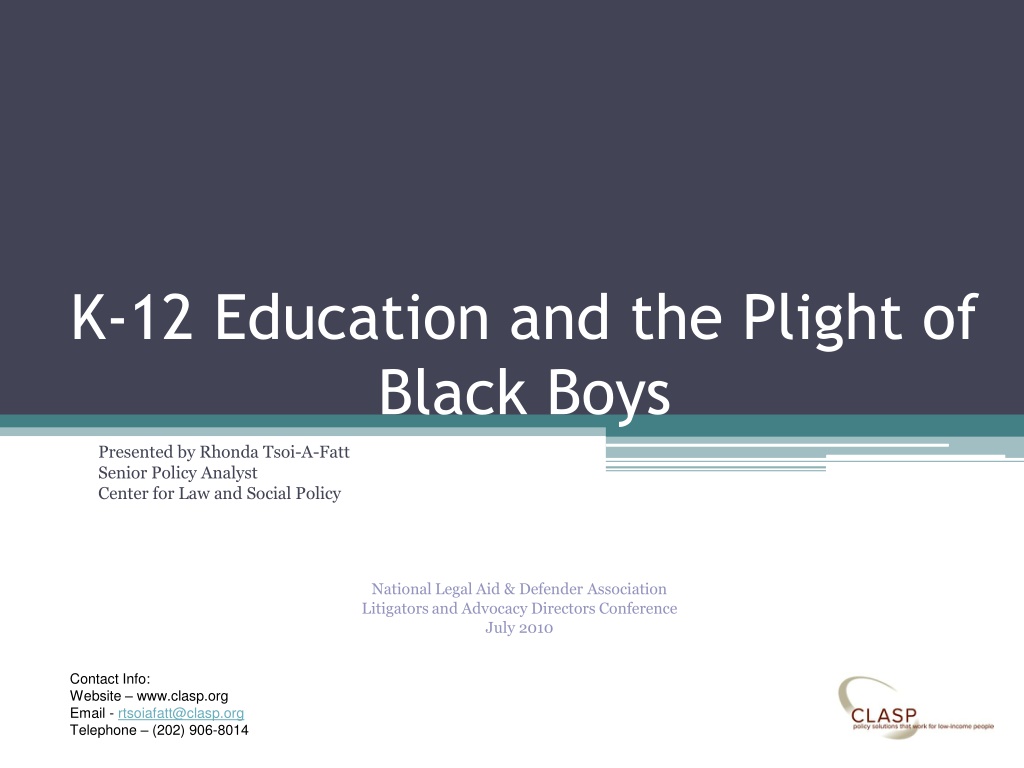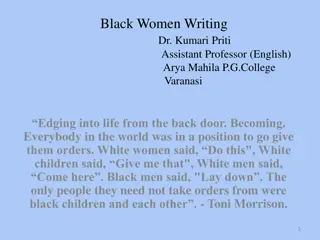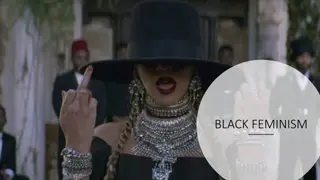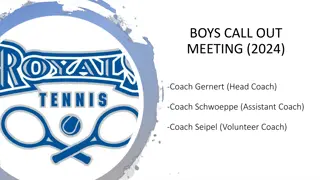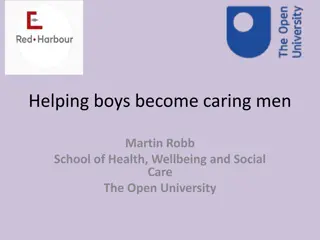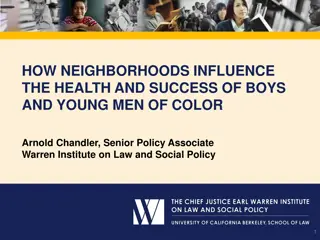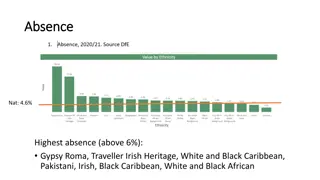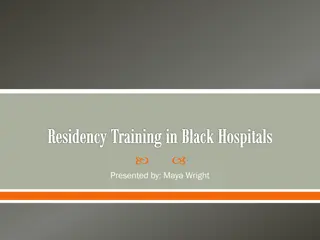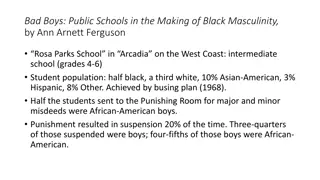Challenges Faced by Black Boys in K-12 Education System
Black male students in the K-12 education system encounter significant disparities in special education, gifted/talented programs, behavior policies, achievement rates, graduation rates, and college readiness. They are over-represented in special education, face barriers in accessing gifted/talented programs, and are disproportionately suspended or expelled, leading to educational setbacks. These issues highlight systemic failures that must be addressed to ensure equitable opportunities for Black boys in education.
Download Presentation

Please find below an Image/Link to download the presentation.
The content on the website is provided AS IS for your information and personal use only. It may not be sold, licensed, or shared on other websites without obtaining consent from the author. Download presentation by click this link. If you encounter any issues during the download, it is possible that the publisher has removed the file from their server.
E N D
Presentation Transcript
K-12 Education and the Plight of Black Boys Presented by Rhonda Tsoi-A-Fatt Senior Policy Analyst Center for Law and Social Policy National Legal Aid & Defender Association Litigators and Advocacy Directors Conference July 2010 Contact Info: Website www.clasp.org Email - rtsoiafatt@clasp.org Telephone (202) 906-8014
Black male students are largely being failed by the K-12 public education system. Six Ways the Failure is Demonstrated: Special Education Gifted/Talented Programs Behavior Policies Achievement Rates Graduation Rates College Readiness Rates
SPECIAL EDUCATION Black students are over-represented in all areas of special education. Black Males in Special Education Black students are diagnosed later than white students for legitimate special needs. 25 20 21.99 Definitions of mildly mentally retarded, developmental delay, and emotionally disturbed are ambiguous, leaving a lot of room for subjectivity in assessment. 19.21 15 Percent 15.25 13.27 10 Many low-income black students enter school unprepared due to lack of quality child care, and are categorized as developmental delay as a result. 8.71 5 0 Black Males Black students are more likely to face traumas in family life that result in behavioral issues and are categorized as ED. K-12 Population Emotionally Disturbed Developmental Delay Mental Retardation Specific Learning Disorder Only 10 percent of black boys who enter special education ever return to the mainstream classroom setting (Kunjufu, 2005) Source: US Dept of Education, Office of Civil Rights, 2006 Data Set
GIFTED/TALENTED PROGRAMS Black male students are far less likely to be placed in gifted/talented programs. Gifted/Talented Program Participation, by Race 40 Black boys are often not allowed participation, despite grades of test score that demonstrate competence. 34.46 30 30.13 Percent 20 There is a great deal of subjectivity in selection for participation. 10 8.58 There is lack of accommodation for gender and cultural difference in learning styles. 3.89 0 Black Males White Males K-12 Population Gifted and Talented Source: US Dept of Education, Office of Civil Rights, 2004 Data Set
BEHAVIOR POLICIES Black boys are more likely to be suspended and expelled from school. Suspension and Expulsion, by Race 35 30 29.1 25 Zero tolerance policies lead to harsh penalties for minor infractions. 28.3 28.2 26.7 Percent 23.7 20 15 17.3 Suspension and expulsion leads to loss of instructional time, causing black male students to fall behind. 14.0 10 10.5 8.7 5 0 Black Males White Males Hispanic Males Black male youth surveyed in dropout recovery programs were more likely to cite suspension and expulsion as their reason for dropping out of high school. K-12 Population Suspension Expulsion Source: US Dept of Education, Office of Civil Rights, 2006 Data Set
LOW ACHIEVEMENT RATES Black male students have lower rates of academic achievement, as measured by standardized examinations. Male Students Lacking Basic Reading and Math Skills, by Race Nationally, half of all black male 8th graders lack basic reading and math skills. 70 60 Even when socioeconomic status is controlled for, Black male students still fare worse. 58 50 54 52 50 Percent 40 44 Under ESEA, schools classified as under improvement, corrective action, or restructuring, students must be given the choice to transfer to a better school within the district or in a neighboring district. This is not a viable solution in many high-poverty, high-minority districts. 41 38 30 29 25 20 19 17 10 Under ESEA, persistently failing schools must provide students with supplemental education services. Research has shown that implementation is flawed and that most students do not access these services. 9 0 4th Grade Reading 4th Grade Math 8th Grade Reading 8th Grade Math Black Males White Males Hispanic Males Black students in middle and high school have even fewer supports because many school districts opt not to use Title I funds in their middle schools or high schools. Source: National Assessment of Educational Progress, 2008 Data Set
LOW GRADUATION AND COLLEGE READINESS RATES High School Graduation Rate of Black Males in Key Communities, 2005-06 School Year Less than half of black male students who enroll in 9th grade will graduate 4 years later. Philadelphia 46 Oakland 43 New York 32 There is a gap between requirements for high school completion and requirements for college admission. Only 20% of black students who graduate from high school are college ready* (Manhattan Institute of Policy, 2003) Los Angeles 41 District of Columbia 55 Cleveland 34 Chicago 37 Baltimore City 31 Atlanta 34 National 47 0 20 40 60 Percent * College readiness is defined as having graduated high school, possessing basic level literacy skills, and having taken four years of English, three years of math, and two years each of natural science, social science, and foreign language. Source: Schott Foundation, 50 State Report Black Male Data Portal, www.blackboysreport.org
Elementary and Secondary Education Act (also known as NCLB) The reporting requirements of the 2001 Reauthorization brought to light many of the disparities we now can quantify. Solutions proposed and put in the reauthorized law were not fully funded, therefore many of the interventions were not fully implemented. Regulatory changes made in 2008 standardized the graduation rate calculation, which allows for even comparison across states and districts. This is not, however, disaggregated by race. American Recovery and Reinvestment Act (ARRA) funds have helped to direct funds and encourage innovative approaches in struggling schools and districts, many of which are high-poverty or high-minority. The current legislation does not prioritize or provide any significant funding for dropout prevention or recovery. Students who drop out face significant difficulties getting back into school or receiving educational services. The current legislation does not go far enough to ensure that homeless students, those in foster care, or those in juvenile detention receive the educational services they need, or that the systems work together to serve the students needs.
Dept of Education Office of Civil Rights Under the current Administration, data collection has been greatly expanded to include the following, beginning with data collected in 2009- 2010 school year: students participation in algebra and other college-preparatory subjects Retention teacher experience/absenteeism school counselors school funding Harassment restraint/seclusion SAT/ACT participation desegregations plans access to kindergarten and pre-kindergarten programs additional information related to discipline Most of the student data collected will be disaggregated by race, sex, disability, and limited English proficient status
What Can You Do? To Help Individual Parents & Students Assist in navigation of the special education process to ensure proper assessment, appropriate placement, regular revisiting of case, etc. Assist in advocating for gifted/talented placement and supports based on the student s academic achievements Assist in having school expulsions evaluated and overturned Assist in actually receiving the services that they are legally entitled to supplemental services and school choice Assist dropouts up to age 21 in getting back into an appropriate educational setting that is operated or funded by the school district Educate parents on the particulars of the IEP process To Make Districts Accountable to All Parents and Students Examine and publicize local district trends for black male student services and outcomes to make the case for closing gaps and reducing disparities Demand a specific, written set of criteria and a uniform assessment process for placement in special education and gifted/talented programs Advocate for the revamping of zero tolerance policies that harm student achievement and lead to dropout Push for supplemental education services to be more accessible to families by providing service options within their communities Ensure that school choice options are made available for all students in failing schools, and that parents are aware of the options Target dropout recovery as a key component that is missing and should be added to school and district activities
